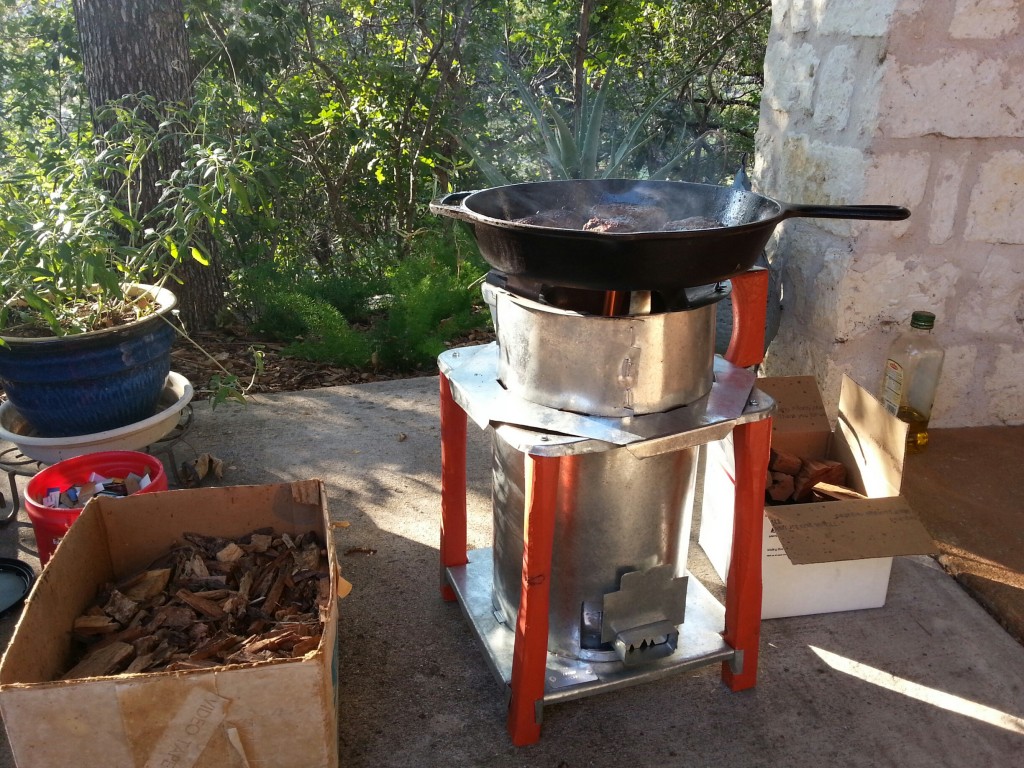A month ago my youngest son and I traveled to Cottage Grove, Oregon to “Stove Camp” at Aprovecho Research Center. Basically, this was a networking event for folks who desire to work with “improved wood stoves”. You see, a half a billion people cook on open fires in the world, and most suffer from a lack of enough fuel and too much smoke inhalation. “Improved Wood Stoves” are about two things: 1.)lower emissions (less particulate matter and lower carbon monoxide) and 2.)more efficient use of scarce wood resources.
Anyway, we spent 3 days camping on a river, working with others from around the world to build and test a variety of stoves using state-of-the-art test equipment. Aprovecho has a huge collection of almost every improved cooking stove ever designed. Simplistically, the stoves tested can be divided into two major categories – Rocket Stoves and Top Lit Updraft Stoves, or TLUD’s. Rocket stoves are based on what I call “verticality”, ie that heat rises. So they concentrate the fire in an area that allows the natural updraft to carry the heat to the pot. Meanwhile, TLUD’s are a little more high tech – they involve burning the wood (or wood gas) in two stages – with a primary stage drying and pyrolizing the wood and generating the wood gas (ie, not enough oxygen to burn it completely), then a second stage burning the wood gas with additional air entry directly under the pot.
Anyway, at the forefront in TLUD stove development is Dr. Paul Anderson, aka Dr. TLUD, aka “Doc”. A retired professor, Doc has been working on this project for about ten years. One of his goals is to perfect a design that will allow local production – almost anywhere in the world – with limited tools and only sheet metal, some wood and few screws. In doing so he achieves the additional goals of providing productive work and keeping the cost low enough that more can afford the stoves. Doc’s most recent stove is called the Quad3 TLUD, and he brought ten of them over from Uganda (pieces made there) in two 50 lb max “suitcase boxes”. We had the good fortune of working with Doc, who showed us how to assemble the stoves and taught us what makes them “tick”. We also purchased two and shipped them back home for further use and testing.
So, Saturday before last my good friend Ray M. and I assembled the two stoves. Our assembly process uncovered some difficulties, but ultimately was successful. In fact, our difficulties have already been “fed back” into the design itself, and the production process. Cool!
What to cook on your new Quad3 TLUD? Why Condalia Farms Brand Steakburger, of course! I fired my Awamu S/N 30238 stove with Ray’s hand chopped mesquite and cardboard starter pieces. It started right up, and soon we were cooking with gas … wood gas that is. We coated the Lodge cast iron skillet with a little olive oil and filled it with exactly 2 pounds of Steakburger patties. Soon I was able to tweak the damper on the stove and create a steady heat. The burgers came out great!
Here we are, just after we began cooking, fuel that was used is in the boxes to the sides:
 Steakburgers about done, here:
Steakburgers about done, here:
 Hats off to Dr. Paul Anderson and his production partners in Uganda for creating a great stove!
Hats off to Dr. Paul Anderson and his production partners in Uganda for creating a great stove!
Oh, you might be wondering what “Awamu” means. Doc says it means “together” in Uganda. Cool word, cooler concept. Seems like a “hyperlink word”, a simple word filled with a broad meaning. After a few days at Stove Camp with some really gifted folks doing work that will help so many, potentially, we totally understand Awamu.
Incidentally, Awamu is our philosophy here at Lone Star Grassfed. We enjoy producing great grassfed beef, free from antibiotics or hormones, for our families and yours.

I mixed one pound of steakburger with 3 small red Bell Peppers fresh out of the garden, plus half a small onion (all diced), some garlic pepper and Mrs Dash seasoning, and cooked them in a cast iron frying pan over a smaller version of that stove. Delicious, and very juicy! Since I had some extra “firepower”, I also boiled two quarts of water and filled a pair of Stanley Thermos Bottles (and wrapped them in some wool cloth) so I will have hot water for tomorrow’s coffee. Then I dumped the charcoal that was created by the TLUD stove into a bucket of water…
Ray I had a bunch of great charcoal after cooking that 2#. I tried to cap the top by putting a steel plate on it, and of course I knew better. All turned to ash. Should have dumped it water or maybe a sealed paint can.